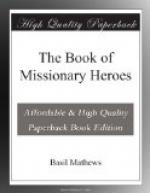To this John Mackenzie quickly agreed, for he too desired that the boy should read.
So the sixteen oxen were yoked to the big wagon, and amid much shouting and cracking of whips and lowing of oxen and creaking of wagon-joints, John Mackenzie, Shomolekae, and the others, started from Kuruman northward to Shoshong.
Now, at Shoshong the chief was Sekhome, who, you remember, in our last story, was father to Khama. So when they were at Shoshong, Shomolekae, the young man who was cook, and Khama, the young man who was the son of the chief, worshipped in the same little church together. It was not such a church as you go to in our country—but just a little place made of mud bricks that had been dried in the sun. There were holes instead of windows, and there was no door in the open doorway; and on the top of the little building was a roof of rough, reedy grass.
These were the days that you heard of in the last story, when Khama, seeing his tribe attacked by the fierce Lobengula, rode out on horseback at the head of his regiment of cavalry and fought them and beat them, and drove away Lobengula with a bullet in his neck.
For two years Shomolekae, learning to read better every day, and serving John Mackenzie faithfully in his house, lived at Shoshong.
Sometimes Shomolekae took long journeys with wagon and oxen, and at the end of two years he went with Mackenzie a great way in order to buy windows, doors, hinges, nails, corrugated iron, and timber with which to build a better church at Shoshong.
When Shomolekae came back again with the wagons loaded up there was great excitement in the tribe. Hammers and saws, screw-drivers and chisels were busy day after day, and the missionary and his helpers laid the bricks one upon another until there rose up a strong church with windows and a door—a place in which the people went to worship God the Father of our Lord Jesus Christ.
Again Shomolekae went away by wagon, and this time he travelled away by the edge of the desert southward until at last he reached the garden at Kuruman where as a boy he used to frighten the birds from the fruit trees. He was now a very clever man at driving wagons and oxen.
This, as you know, is not so easy as driving a wagon with two horses is in Britain. For there were as many as sixteen and even eighteen oxen harnessed two by two to the long iron chains in front of the wagon.
There were no roads, only rough tracks, and the wagon would drag through the deep sand, or bump over great boulders of rock, or sink into wet places by the river. But at such times one of the natives always led the two front oxen through the river with a long thong that was fastened to their horns.
So, in order to drive a wagon well, Shomolekae needed to be able to manage sixteen oxen all at once, and keep them walking in a straight line. He needed to know which were the bad-tempered ones and which were the good, and which pulled best in one part of the span and which in another; and how to keep them all pulling together and not lunging at one another with their horns.




